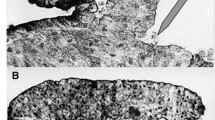Summary
Whorls of sterile hairs inA. mediterranea show, at the moment of first appearance of hair initials, a spacing independent of number of hairs in the whorl but dependent on temperature. By changing the temperature at various times before appearance of hair initials, the pattern-forming event can be located at about 3–4 hours before initials become visible.
The temperature dependence of spacing is like that of a chemical rate parameter: In (spacing)versus 1/T is linear. This suggests that the spacing is controlled by kinetic rather than structural factors, and correlates well with reaction-diffusion theory.
Mathematical analysis and computer simulation have been used to show that the observed sequence of tip-flattening followed by whorl initiation can be interpreted in terms of published models for generation of “dissipative structures” by reaction and diffusion, and that at least two sequential processes must occur, the first of which shifts growth activity from extremity to circumference of the growing tip, permitting the second to operate around the circumference.
Similar content being viewed by others
References
Bonotto, S., Puiseux-Dao, S., 1970: Modification de la morphologie des verticelles et différenciation chez l'Acetabularia mediterranen. C. R. Acad. Sci. Paris270, 1100–1103.
Gierer, A., Meinhardt, H., 1972: A theory of biological pattern formation. Kybernetik12, 30–39.
Glansdorff, P., Prigogine, I., 1971: Thermodynamic theory of structure, stability and fluctuations. London-New York: Wiley.
Green, B. R., 1977: The effects of natural and synthetic sea water media on the growth and reproduction ofAcetabularia. Phycologia16, 87–94.
Green, P. B., King, A., 1966: A mechanism for the origin of specifically oriented textures in development with specific reference toNitella wall texture. Austral. J. biol. Sci.19, 421–437.
Harrison, L. G., Lacalli, T. C., 1978: Hyperchirality: a mathematically convenient and biochemically possible model for the kinetics of morphogenesis. Proc. Roy. Soc. London B202, 361–397.
Lacalli, T. C., 1980: Personal communication based on E. M.s obtained from S. Berger.
—,Harrison, L. G., 1978: Development of ordered arrays of cell wall pores in desmids: a nucleation model. J. theor. Biol.74, 109–138.
Lehninger, A. L., 1975: Biochemistry, Chap. 36. New York: Worth Publishers.
Loni, M. C., Bonotto, S., 1971: Statistical studies on cap morphology in normal and branchedAcetabularia mediterranea. Arch. Biol. (Liège)82, 225–244.
—,Nicolas, C., Felluga, B., Bonotto, S., 1975: Cap morphology statistics on a natural population ofAcetabularia mediterranea. Arch. Biol. (Bruxelles)86, 413–421.
Martynov, L. A., 1975: A morphogenetic mechanism involving instability of initial form. J. theor. Biol.52, 471–480.
Puiseux-Dao, S., 1970:Acetabularia and cell biology, transi.Malpoix-Higgins, P. (a) p. 125 sqq. (b) p. 38. New York: Springer.
Shepard, D. S., 1970: Axenic culture ofAcetabularia in a synthetic medium. In: Methods of cell physiology, Vol. IV, pp. 49–69 (Prescott, D., ed.). New York: Academic Press.
Schweiger, H. G., Schweiger, M., 1977: Circadian rhythms in unicellular organisms: an endeavour to explain the molecular mechanism. Int. Rev. Cytol.51, 315–342.
Turing, A. M., 1952: The chemical basis of morphogenesis. Phil. Trans. Roy. Soc. London B237, 37–72.
Vanden Driessche, T., 1979: Phase-shifting effect of IAA on the photosynthetic circadian rhythm ofAcetabularia. In: Developmental biology ofAcetabularia, pp. 195–204 (Bonotto, S., Kefeli, V., Puiseux-Dao, S., eds.). Amsterdam: Elsevier North Holland Biomedical Press.
Werz, G., 1966: Primärvorgänge bei der Realisation der Morphogenese vonAcetabularia. Planta69, 53–57.
Author information
Authors and Affiliations
Additional information
Submitted to workshop on Morphogenesis inAcetabularia, Berlin (West), September 1980.
Rights and permissions
About this article
Cite this article
Harrison, L.G., Snell, J., Verdi, R. et al. Hair morphogenesis inAcetabularia mediterranea: Temperature-dependent spacing and models of morphogen waves. Protoplasma 106, 211–221 (1981). https://doi.org/10.1007/BF01275553
Received:
Accepted:
Issue Date:
DOI: https://doi.org/10.1007/BF01275553




